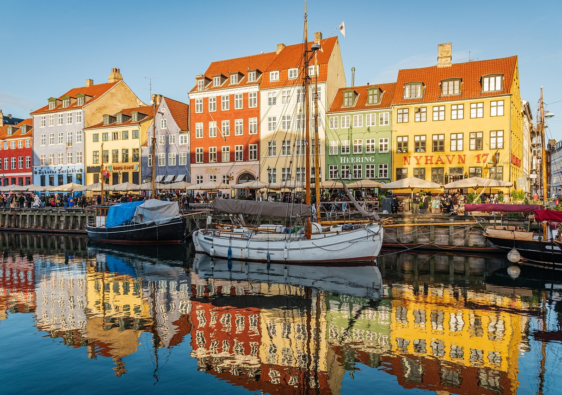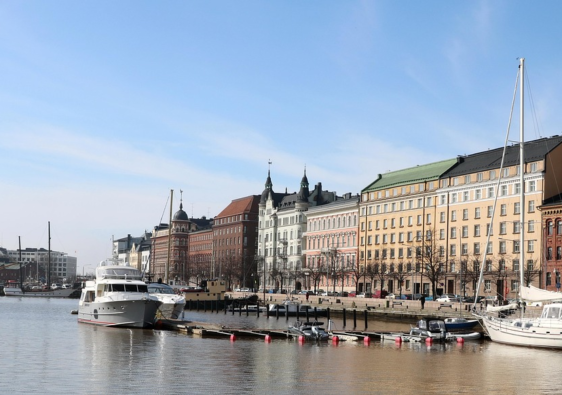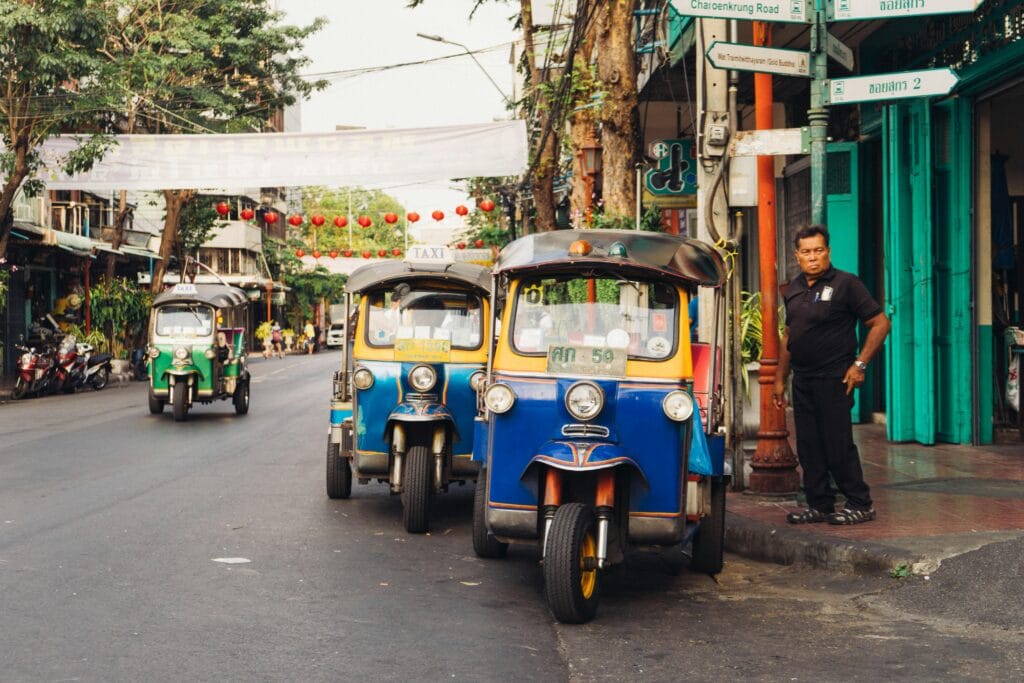
There’s a reason Thailand ends up on nearly everyone’s travel list and usually at the top. It’s the kind of place that gets under your skin quickly: the smell of sizzling street food drifting through alleyways, the golden glow of temple spires at sunset, the easy smiles from locals that make even the busiest Bangkok street feel welcoming. Thailand has this rhythm to it, fast and chaotic one moment, slow and reflective the next, and it’s what makes travelling here so addictive.
For first-time visitors, Thailand is the perfect introduction to Southeast Asia. It’s organised enough that you can travel comfortably, but still full of those wonderfully unpredictable moments that make travelling feel real again.
Here are the basics:
- Capital: Bangkok
- Language: Thai (English widely spoken in tourist areas)
- Currency: Thai Baht (THB)
- Population: ~70 million
- Religion: Predominantly Buddhism
- Electricity: 220V, plug types A/B/C
- Timezone: GMT+7
- Visa: 30-day visa-free entry for most nationalities (extendable)
- Best time to visit: November–April
Thailand’s appeal isn’t just in its landscapes, it’s in the contrast. One moment you’re bartering over pad kra pao at a street stall, the next you’re floating past limestone cliffs that look like something out of a dream.
Why Visit Thailand
Thailand somehow feels like ten destinations in one, and that’s exactly why people fall for it. Whether you’re after adventure, culture, beaches, or just a reset, there’s a version of Thailand that fits. It’s not just about ticking off temples or islands; it’s about the feeling of the place, the chaos of Bangkok, the calm of the north, and how every meal feels cooked just for you.
Travelling here is effortless but never dull; everything works, yet there’s still room for spontaneity. It’s affordable without feeling cheap, developed without losing character, and welcoming without being overrun. You’ll eat like royalty for pocket change, sleep comfortably, and still find something new every day.
What makes Thailand special is how it teaches you to travel well, trust detours, follow local tips, and enjoy getting lost. Everyone here finds their own version of Thailand, and that’s exactly what keeps people coming back.
If you’re still wondering why so many people start their Southeast Asia journey here, here’s what keeps them coming back:
- Street food culture: Some of the best, cheapest, and most flavourful food on the planet.
- Island life: From party spots to total peace, there’s a beach for every mood.
- Temples & spirituality: Golden stupas, ancient ruins, and a quiet sense of calm in between the chaos.
- Adventure: Jungle treks, scuba diving, night markets, and a motorbike loop are all within reach.
- Affordability: You can live well here without spending much at all.
- People: Kind, patient, and proud to share their country — the “Land of Smiles” isn’t just a slogan.
Getting Your Bearings: The Lay of the Land
Before diving into the details of where to go, it helps to understand how Thailand fits together because it’s bigger and more diverse than most first-time visitors expect. The country stretches over 1,600 kilometres from the misty mountains of the north down to the turquoise seas of the south. Each region feels like its own world, with different rhythms, foods, landscapes, and even accents.
Here’s a quick breakdown of the main regions and what they’re known for:
Northern Thailand
Think jungles, temples, and mountains. The north is where you’ll find Chiang Mai, Chiang Rai, and Pai places that slow you down in the best way. The weather’s cooler, the air feels cleaner, and the culture has a depth you’ll feel instantly. It’s perfect for those who love nature, trekking, and slower, more soulful travel. The north is also a hub for traditional Thai cooking classes, meditation retreats, and ethical elephant sanctuaries.
Central Thailand
This is where it all begins for most travellers Bangkok. Loud, energetic, and full of contrasts, it’s a city that takes a minute to figure out but rewards you once you do. You’ll find glittering temples tucked between rooftop bars, and street stalls that outshine most restaurants back home. Just north of the capital lies Ayutthaya, Thailand’s old capital, with ancient ruins that whisper stories from centuries ago.

Southern Thailand (Andaman Coast)
Over on the west coast, you’ve got the Andaman Sea, home to Phuket, Krabi, Koh Phi Phi, and Koh Lanta. Think dramatic limestone cliffs, turquoise bays, and longtail boats drifting through clear waters. This side of the country is known for its postcard beaches, epic diving, and that relaxed island pace that makes you forget what day it is.
Southern Thailand (Gulf Coast)
The east coast faces the Gulf of Thailand and has its own distinct vibe. Here you’ll find Koh Samui, Koh Phangan, and Koh Tao each island with its own personality. Samui has resorts and comfort, Phangan has both full-moon parties and quiet yoga retreats, and Tao is all about diving and laid-back charm. The water here tends to be calmer than the Andaman side, making it great for swimming and snorkelling.
Northeastern Thailand (Isaan)
Far fewer tourists venture here, but those who do often call it the “real Thailand.” Isaan is rural, friendly, and deeply traditional with ancient Khmer ruins, spicy food, and festivals that feel untouched by mass tourism. It’s a rewarding detour if you want to see life beyond the tourist trail.
When to Visit Thailand
Thailand’s one of those countries worth visiting any time of year, but when you go, it can completely change your trip. You’ll often hear people say “there’s no bad time to visit,” which is mostly true… as long as you know what you’re signing up for. Broadly speaking, Thailand has three main seasons: cool & dry, hot, and rainy. But here’s the catch: because of the country’s shape, the weather isn’t the same everywhere at once.

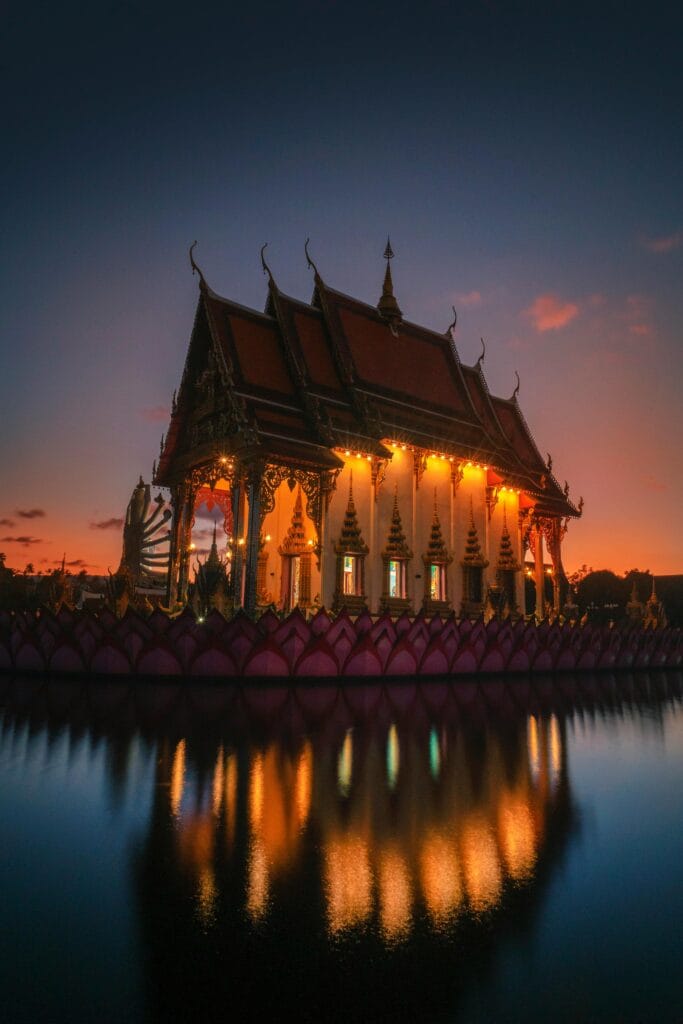
Here’s how it breaks down:
Cool & Dry Season (November – February)
This is Thailand at its best blue skies, lower humidity, and that perfect warm-but-not-suffocating temperature. It’s the peak season for a reason: beaches are at their finest, hiking trails are open, and most of the country feels like a dream to explore. The only downside? Prices go up, and you’ll need to book accommodation earlier. Still, if it’s your first visit, this is hands down the most comfortable time to go.
Best for: First-timers, beach days, outdoor exploring, and island hopping.
Where to go: Anywhere! North, south, central — the weather’s on your side.
Hot Season (March – May)
This is when the sun really shows its strength. Temperatures can climb into the high 30s, and sightseeing in the middle of the day starts to feel like a workout. That said, the islands get a lovely breeze, and this is when prices dip again after peak season. The Thai New Year (Songkran) also falls in April a nationwide water fight that’s pure joy and chaos rolled into one.
Best for: Budget travellers, festival lovers, water babies.
Where to go: Head to the South Island, life feels cooler than city life in the heat.
Rainy/Green Season (June – October)
Don’t be put off by the word “rainy.” It rarely rains all day more often you’ll get a short, dramatic downpour followed by clear skies. Everything turns lush and green, waterfalls are at their strongest, and crowds drop dramatically. It’s also when accommodation and flight prices plummet, making it great value.
Best for: Off-season explorers, photographers, slower travel.
Where to go: The Gulf Coast (Koh Samui, Koh Phangan, Koh Tao) gets less rain than the Andaman side during these months.
Quick Tips for Timing Your Trip
- Peak travel months: December to February book early.
- Cheapest months: May to October expect afternoon rain, not total washouts.
- Festival highlights:
- Songkran (April): Thai New Year, country-wide water festival.
- Loy Krathong (November): Thousands of floating lanterns lighting up the night.
In short, there’s no wrong time to visit Thailand there are just different versions of it depending on when you go.
Where to Go in Thailand (By Region)
Trying to plan your Thailand route can feel like being handed a menu with too many good options, temples, jungles, beaches, islands, cities. The truth is, wherever you go, you’ll find something that hooks you. But each part of the country has its own distinct character, and knowing that helps you build a trip that actually flows.
Below is a breakdown of Thailand’s main regions and what makes them special — so you can piece together the version of Thailand that fits you.
Northern Thailand – Mountains, Temples & Slow Living
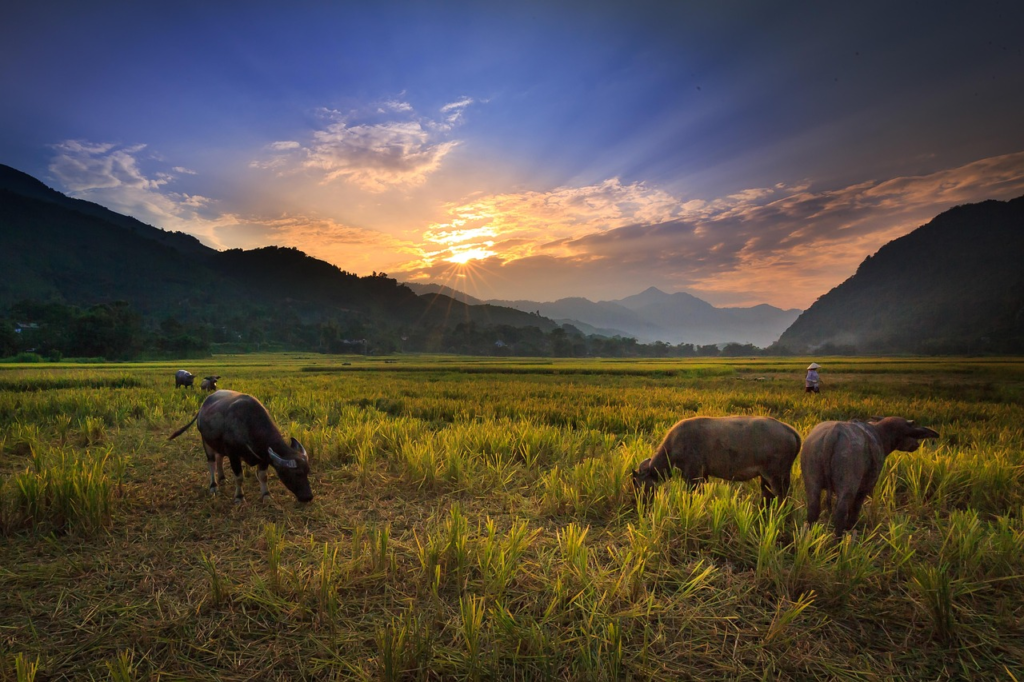
If you’re craving a gentler pace, the north is where to start. The air feels cooler, the scenery greener, and life moves at a more reflective rhythm. It’s a world of Buddhist temples, misty hills, and old wooden houses that creak with history.
- Chiang Mai – The north’s beating heart. A city where golden temples meet hip cafés and night markets that feel endless. It’s the kind of place you plan to stay three days and end up staying three weeks. Great for cooking classes, elephant sanctuaries (the ethical kind), and temple-hopping.
- Pai – A small mountain town with a big reputation. Winding roads, waterfalls, hot springs, and a bohemian feel that draws backpackers and free spirits alike. Rent a scooter, chase sunsets, and let the days blur together.
- Chiang Rai – Quieter and less polished, home to the dazzling White Temple and laid-back local life. Ideal if you want something more under-the-radar.
Go north if you want to slow down, eat well, and breathe in mountain air instead of exhaust fumes.
Central Thailand – Culture, Chaos & City Life
The middle of the country is where the pulse is strongest. Central Thailand is home to Bangkok, a city that somehow works despite appearing completely unhinged. It’s where ancient tradition meets flashing neon, and where a five-star rooftop bar can sit right next to a street food stall serving 50p pad thai.
- Bangkok – A sensory overload that every traveller should experience. Visit the Grand Palace, cruise down the Chao Phraya River, and get lost in Chinatown’s backstreets. At first it’s chaos; then it becomes a kind of rhythm you can’t get enough of.
- Ayutthaya – Just a couple of hours north of Bangkok, this former capital is a UNESCO World Heritage site filled with ancient ruins and crumbling temples. You can explore by bike and feel like you’ve time-travelled a few hundred years.
- Kanchanaburi – A riverside town with a tragic WWII history, home to the famous Bridge over the River Kwai and surrounded by waterfalls and national parks.
Go central for energy, culture, and a reminder that cities can be as memorable as beaches.
Southern Thailand (Andaman Coast) – Cliffs, Islands & Blue Water
The Andaman side is Thailand’s showstopper, the one you see in travel posters. Towering limestone cliffs, turquoise bays, and longtail boats drifting through water that looks almost too blue to be real.
- Phuket – Thailand’s biggest island and a gateway to the Andaman. It’s got everything from flashy resorts and beach clubs to quiet corners where you can disappear for a few days.
- Krabi & Ao Nang – Base yourself here for kayaking, island-hopping, and those famous Railay cliffs. More relaxed than Phuket, but still with plenty of life.
- Koh Lanta – Quieter and more down-to-earth. Think palm-fringed beaches, gentle sunsets, and family-run bungalows. My personal pick if you want balance a little nightlife, a lot of calm.
- Koh Phi Phi – The party island that never sleeps. It’s stunning, yes but busy. Great if you’re after that mix of beauty and buzz.
Go west if you want that “Thailand dream” think turquoise seas, cliffs, and a sundowner in your hand.
Southern Thailand (Gulf Coast) – Calm Seas & Island Energy
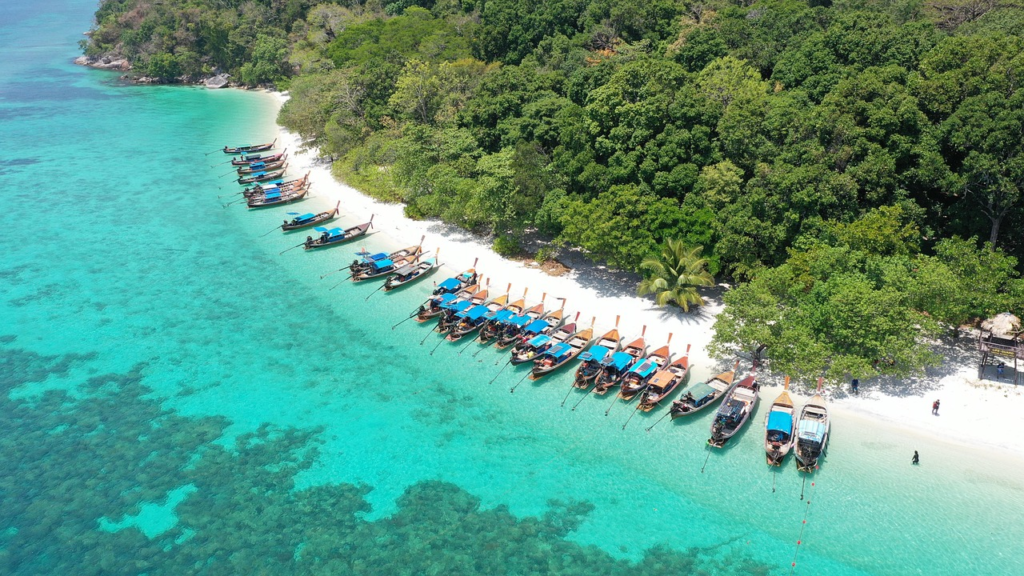
Across the peninsula, the Gulf side feels softer and calmer. The seas are gentler, the weather slightly different, and each island has its own identity.
- Koh Samui – The all-rounder. Big enough to have luxury resorts, yoga retreats, and local night markets all side by side.
- Koh Phangan – Famous for the Full Moon Party, but the rest of the island is the exact opposite, peaceful beaches, jungle bungalows, and meditation retreats.
- Koh Tao – A diver’s paradise. It’s small, easy to get around, and the kind of place where days melt into one another.
Go east if you want easygoing island life with calm waters and great diving.
Northeastern Thailand (Isaan) – The Road Less Travelled
Few tourists make it out here, which is exactly why it’s worth it. Isaan is Thailand’s agricultural heartland — authentic, raw, and quietly beautiful. Expect friendly locals, spicy food, and temples without tour groups.
- Ubon Ratchathani, Khon Kaen, Nong Khai – Names most visitors never hear, but the kind of places where you’ll see Thailand as it truly is. Home to festivals, local markets, and warm hospitality that feels deeply genuine.
Go northeast if you’re craving real, off-the-map experiences.
Thailand’s diversity is what makes it so special. You can have a completely different trip from someone else, and both of you will be right. Whether you want to eat street noodles until midnight, hike through rainforest, dive coral reefs, or just swing in a hammock for a week, it’s all here.
And the best part? Every region connects easily, so if you can’t choose, don’t.
Mix them. Move slowly. Let the country guide you.
Top Things to Do in Thailand
Here are the moments and experiences that really capture what Thailand’s all about a mix of the iconic, the unexpected, and the deeply local.
- Eat street food everywhere
- Explore temples in Bangkok & Chiang Mai
- Ride a longtail boat through turquoise water
- Learn Thai cooking or Muay Thai
- Visit ethical elephant sanctuaries
- Watch island sunsets with a cold drink
- Take a train journey – slow but unforgettable
- Rent a scooter (safely!)
- Go diving or snorkelling
- Join Songkran or Loy Krathong
- Visit Khao Sok National Park
- Meet locals – the true highlight
Food & Drink!
Thailand’s street food scene is legendary, and for good reason. It’s cheap, fresh, fast, and somehow always perfect. Every stall specialises in just one or two dishes, which means they’ve perfected them over years, sometimes decades.

Must-try classics include:
- Pad Thai – Stir-fried noodles with egg, peanuts, and lime.
- Pad Kra Pao – Spicy basil stir-fry, usually with minced pork or chicken and a fried egg on top.
- Som Tam – Green papaya salad, crunchy, tangy, and fiery all at once.
- Tom Yum Goong – Hot and sour shrimp soup with lemongrass and lime leaves.
- Khao Man Gai – Thai-style chicken and rice, simple and comforting.
- Mango Sticky Rice – Sweet, sticky perfection with ripe mango and coconut cream.
Drinks & Refreshers
- Thai Iced Tea (Cha Yen): Sweet, milky, and dangerously addictive.
- Fresh Coconut Water: Sold chilled straight from the shell, perfect in the heat.
- Fruit Shakes: Mango, pineapple, watermelon, made fresh on every corner.
- Chang or Leo Beer: The go-to local beers; cheap, easy to find, and perfect with spicy food.
- Singha Beer: Slightly pricier, smoother, often preferred by locals.
Street food is the real Thailand. If locals are eating there, so should you, but trust your eyes.
Vegan & Vegetarian Options
Thailand’s Buddhist roots mean meat-free food is easy to find, especially if you know what to ask for.
- Say “Jay” (pronounced “chay”) to mean fully vegan, no meat, fish sauce, or eggs.
- Dishes like Pad Thai Jay, Green Curry Jay, or Vegetable Fried Rice are common.
There are also dedicated vegetarian restaurants, particularly in Chiang Mai, Bangkok, and on the islands.
Eating on a Budget
You can eat incredibly well for next to nothing.
- Street food: £1–£2 per dish
- Local restaurants: £2–£4
- Mid-range cafes: £5–£10
- Western restaurants: £10+ (usually not worth it unless you need a break from rice)
Traveller insight: The best food isn’t in fancy places, it’s in the spots with a plastic chair, one wok, and a queue.
A Few Things to Know
- Tap water isn’t safe to drink, always use bottled or refill from filtered stations.
- Don’t expect Western-style breakfasts unless you’re in hotels; Thai breakfast is rice, noodles, or soup.
- If you can handle spice, great. If not, say “Mai pet” (not spicy) and even then, expect a little kick.
Practical Travel Tips
Thailand is one of the easiest countries in the world to travel, but there are a few things you only learn once you’re actually here. The small stuff that makes the difference between a smooth trip and an exhausting one.
Money & ATMs
The local currency is the Thai Baht (THB), and cash still rules. You’ll use it for everything from food stalls to scooter rentals.
- ATMs are everywhere, but most charge around 220 THB (£5) per withdrawal. It’s often better to take out more at once.
- Card payments work fine in bigger hotels, restaurants, and malls, but expect cash only in most small places.
- Currency exchange booths (especially SuperRich in Bangkok) offer far better rates than airport kiosks.
- Always keep small notes for taxis and markets 1000-baht bills can be hard to break.
Bring a fee-free travel card like Revolut, Monzo, or Wise, they’ll save you a small fortune in ATM and conversion fees.
SIM Cards & Connectivity
Thailand’s mobile data is fast, cheap, and reliable.
- You can grab a tourist SIM right at the airport, AIS, TrueMove, or DTAC are the big three.
- Apps such as Holifay now allow you to buy an e-sim straight from your phone, so you can access the internet anywhere.
- Expect to pay around 200–400 THB (£4–£8) for a week or two of unlimited data.
- Coverage is great even on most islands.
- If you’re staying longer, you can buy or top-up easily at 7-Eleven.
Don’t rely solely on Wi-Fi. Data helps with Grab rides, maps, translations, and checking ferry times when you’re halfway down a pier with no signs in English. The signal has been incredible from my experience.
Getting Around
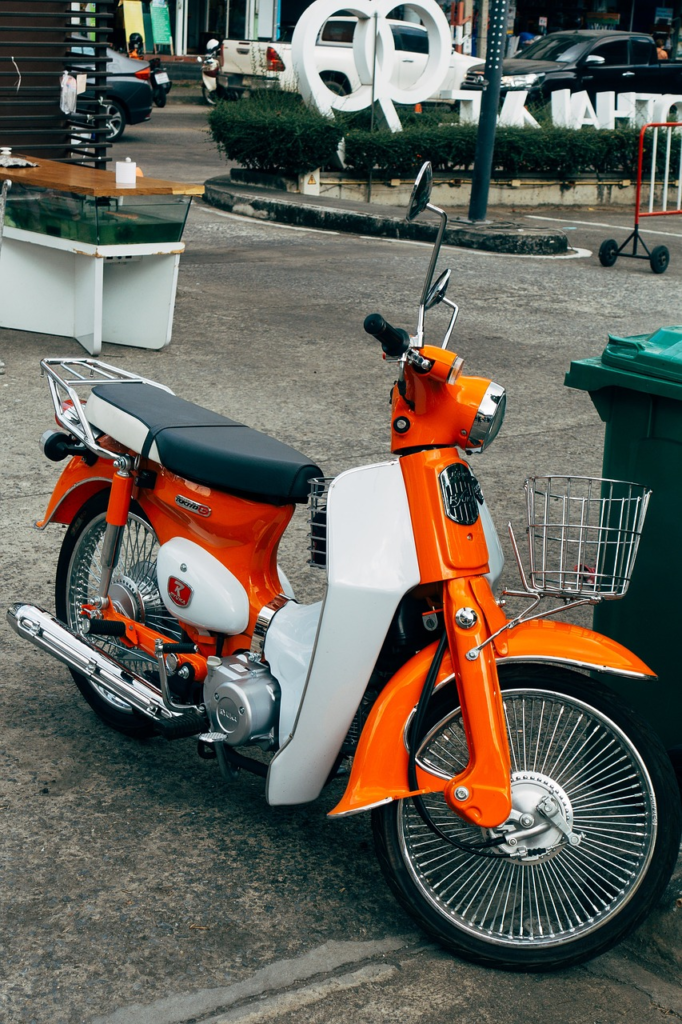
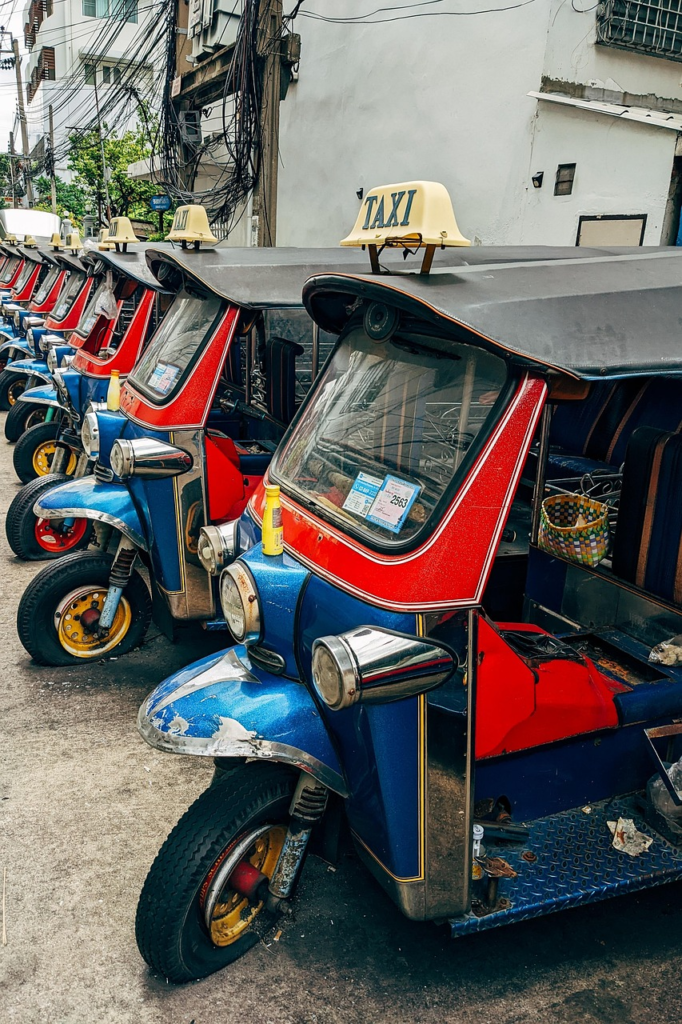
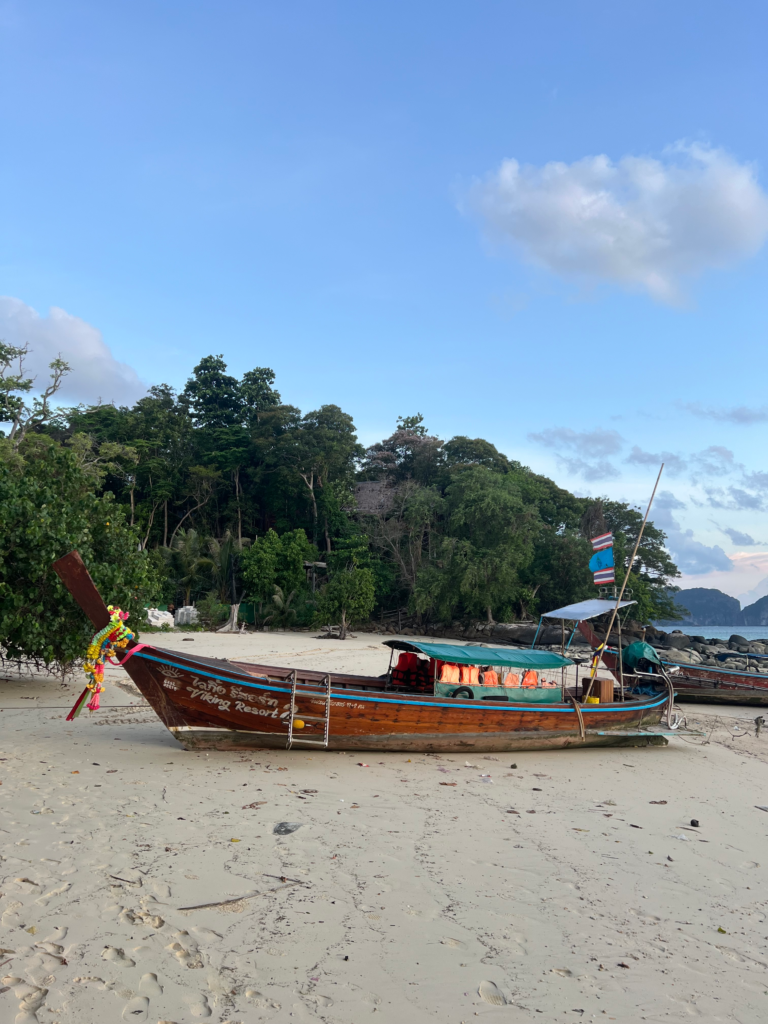
Thailand’s transport network is excellent — just not always on time.
- Domestic flights: Quick and cheap, Bangkok Airways, AirAsia, and Nok Air all serve most routes.
- Trains: Scenic but slow — ideal for overnight trips (Bangkok ↔ Chiang Mai is the classic).
- Buses: Comfortable and inexpensive. VIP or “1st class” buses are worth the few extra pounds.
- Tuk-tuks: Fun for short city rides, but agree on the price before you hop in.
- Grab app: The Thai version of Uber, reliable and cheaper than taxis in cities.
- Scooters: Common on islands and in the north. Always wear a helmet, drive cautiously, and check if your insurance covers motorbike rental (most don’t by default).
Night buses and trains are great for saving a night’s accommodation — but bring earplugs, a hoodie, and low expectations for sleep.
Accommodation
Thailand has a huge range, from £4 dorm beds to £400 villas.
- Hostels: Friendly, clean, often with private rooms, perfect for solo travellers.
- Guesthouses: Family-run, homely, and usually include a good breakfast.
- Hotels/Resorts: Affordable luxury compared to Western prices.
- Beach bungalows: Simple and peaceful, just check reviews for bugs and noise.
Health & Safety
Thailand is generally very safe, but common sense goes a long way.
- Don’t drink tap water; use bottled or refill from filtered stations.
- Wear mosquito repellent, especially in the evening.
- Travel insurance is a must, even a small scooter fall or food bug can get pricey without it.
- Petty theft is rare but keep an eye on your bag in crowded markets and buses.
- Avoid drugs completely, penalties are harsh and not worth the risk.
Visas & Entry
Most visitors from the UK, EU, and many other countries get 30 days visa-free on arrival.
- You can extend it once in-country for another 30 days at immigration offices (around 1900 THB / £40).
- Longer stays (like digital nomads) often use visa runs or special long-stay visas, easy to research online before coming.
Packing Essentials
Light and simple is the way to go.
- Breathable clothes, it’s hot year-round.
- Light rain jacket or poncho.
- Reusable water bottle (many hostels have refill stations).
- Power adapter (Type A/B/C).
- Sunscreen (it’s expensive in Thailand).
- Flip-flops, trainers, and something temple-appropriate.
- Small first-aid kit, plasters, antiseptic wipes, paracetamol.
Pack half of what you think you need. Laundry’s cheap, and you’ll end up buying local clothes anyway.
Common Scams to Watch For
Thailand’s safe, but tourists are easy targets for small-time scams.
- Tuk-tuk drivers offering “cheap tours” they’ll take you shopping instead.
- Jet ski rental damage claims, take photos before and after.
- “The temple is closed” trick, it’s not. Politely ignore and walk away.
- Tailor shops pushing “special deals” some are fine, others not.
General Survival Tips
- The heat is real, drink water constantly.
- Carry tissues or wipes, many public toilets don’t have paper.
- 7-Eleven is your best friend, snacks, SIM cards, ATMs, even toasties at 3 a.m.
- Don’t stress too much about plans. Buses will be late, ferries will change, and somehow, it’ll all still work out.
| Type | Daily Budget | What it Feels Like |
| Backpacker | £25-£40 | Hostels, street food, freedom |
| Mid-Range | £50-£100 | Private rooms, comfort, flexibility |
| Luxury | £150+ | Villas, spas, private tours |
Thailand can be as cheap or as fancy as you make it. You can eat for £2 or £20, sleep in a bamboo hut or a luxury villa, and both will probably come with the same beautiful sunset. The trick isn’t finding the cheapest or the fanciest experience, but the one that feels right for your trip.
Sample Itineraries

Here are a few tried-and-tested routes that work beautifully for first-time visitors.
1 Week – The Classic First-Timer
Bangkok → Krabi / Koh Lanta (or Phuket)
If you’ve got just a week, it’s best to keep it simple and focus on quality, not quantity.
Day 1–2: Bangkok
Start in the capital, chaotic, colourful, and full of energy. Visit the Grand Palace, Wat Pho, and take a sunset ferry along the Chao Phraya River. Get lost in Chinatown, eat your way through street stalls, and take in a rooftop sunset to see the city light up.
Day 3–7: The South (Krabi, Koh Lanta, or Phuket)
Fly south and slow the pace down. Spend your days swimming, kayaking, island-hopping, or just letting life revolve around sunrise swims and beach dinners. Koh Lanta is perfect if you want peace, Krabi if you want a mix of adventure and accessibility, and Phuket if you prefer more options and nightlife.
2 Weeks – The Balanced Adventure
Chiang Mai → Bangkok → Islands (Andaman or Gulf Coast)
This is the ideal first-timer route, a little bit of everything Thailand does best.
Days 1–5: Chiang Mai
Fly straight north to Thailand’s cultural capital. Spend your mornings exploring temples, your afternoons at cooking classes or ethical elephant sanctuaries, and your evenings wandering the night bazaars. Add a side trip to Pai if you’ve got a couple of spare days, it’s a mountain town with a dreamy, laid-back vibe.
Days 6–8: Bangkok
Fly or train south to Bangkok for a dose of urban life. Explore Chinatown, take a canal tour, and eat your weight in street food. A rooftop cocktail at sunset is basically a rite of passage.
Days 9–14: Southern Thailand (Islands)
Finish strong on the coast.
- Andaman side (West): Krabi, Koh Lanta, or Phuket, for those dramatic cliffs and turquoise bays.
- Gulf side (East): Koh Samui, Koh Phangan, or Koh Tao, for calm seas and diving.
3–4 Weeks – The Full Thailand Experience
Bangkok → Chiang Mai / Pai → Islands → Optional Detour
With a month, you can breathe. You’ll have time to travel overland, linger longer, and find those smaller, local gems most people miss.
Days 1–4: Bangkok & Ayutthaya
Start with Bangkok, then take a short train or bus to Ayutthaya for a day among ancient temple ruins.
Days 5–10: Chiang Mai & Pai (North)
Take the overnight train north, it’s an experience in itself. Split your time between Chiang Mai’s culture and Pai’s mountain calm. Rent a scooter, chase waterfalls, and stay in a bamboo bungalow for the full northern vibe.
Days 11–14: Back to Bangkok (optional stop in Kanchanaburi)
Kanchanaburi’s riverside setting and history (Bridge on the River Kwai, waterfalls, national parks) make for a perfect midway stop.
Days 15–28: The South (Pick Your Coast)
- Andaman Coast: Krabi → Koh Lanta → Koh Phi Phi → Phuket.
- Gulf Coast: Koh Samui → Koh Phangan → Koh Tao.
Island-hop, dive, snorkel, and relax. Maybe even take a few days for a yoga retreat or just exist in that hammock you keep meaning to leave.
Quick Planning Notes
- Domestic flights: Cheap and save time, perfect for linking north and south.
- Trains and buses: Slower but authentic, and cheaper for long stays.
- Weather: North and south don’t always share the same dry season, so check before committing to islands.
Festivals & Responsible Travel
Fesitvals
- Songkran (April): Country-wide water fight & joy explosion.
- Loy Krathong (Nov): Lanterns float into the night.
- Phi Ta Khon (Jun): Ghost masks & dancing in Isaan.
- Chinese New Year: Lanterns & street feasts in Chinatown.
- Vegetarian Festival (Oct): Spiritual, colourful, and full of tofu.
- Surin Elephant Festival: Tradition meets conservation.
Responsible Travel
- Go Ethical: No elephant rides or performing animals.
- Stay Local: Guesthouses, local tours, and family-run restaurants.
- Protect Nature: Reef-safe sunscreen, no plastic, leave no trace.
- Travel Slowly: Fewer flights, more connection.
- Be Kind: Thailand gives warmth, return it.
You’ll arrive for the beaches and temples, but you’ll stay for the feeling: the warmth, the food, the laughter, the little daily magic.
Whether it’s your first trip or your tenth, Thailand has a way of pulling you back — not just because of what you see, but because of how it makes you feel.



